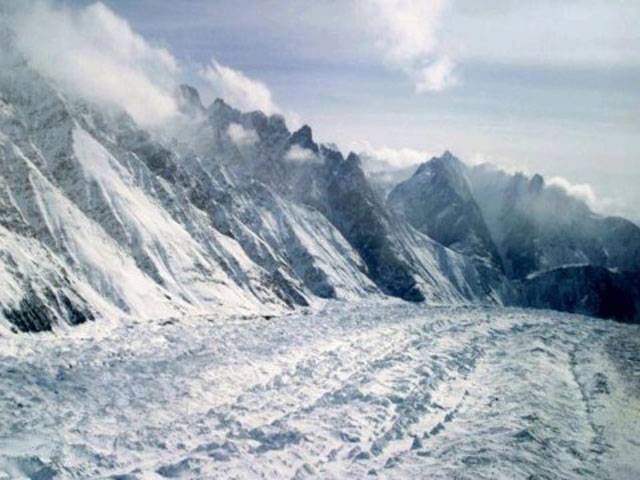ISLAMABAD – Saturday was a sad day for Pakistan as its adored army lost about 124 soldiers – deployed at remote northern border with India to thwart any threat to their motherland.The attack did not come from the forces of the conventional enemy, rather it was the nature – known for its indiscriminate assails – that unleashed a devastating avalanche engulfing an entire camp of the army in Skardu. Eleven were civilians among the causalities suffered in this remote area billed as the world’s highest battleground near Siachen.This battalion headquarter of Northern Light Infantry (NLI), an operational regiment based in Gilgit-Baltistan, was situated at the urban region of Gayari.Troops with sniffer dogs, aided by helicopters, were frantically trying to find signs of life in the deep snow after the avalanche hit the camp in this mountainous Himalayan region. A team of doctors and paramedics also rushed to the high-altitude militarised region, where temperatures plummet to minus 70 degrees Celsius (minus 94F).The Army Aviation Corps (AAC) reportedly led the rescue operations. Till the filing of this report on Saturday night, the rescue operations were underway but there was no confirmed report of any success. The number of any additional causalities and injuries, if any, was also not known.“Snow slide is covering an area of 1 square kilometre. The battalion headquarter was situated at same place for last 20 years and no incident of this nature has happened,” Inter-Services Public Relations (ISPR) said. “However, immediately after the incident, rescue efforts started… Heavy engineering machinery has been moved from Rawalpindi by air,” it added.The avalanche is believed to have hit the military camp during early Saturday hours before sunrise when the soldiers were asleep. “They didn’t get a chance to save themselves,” officials said.Reportedly, the affected lot included some senior army officers up to the rank of lieutenant colonels (number not specified). Majority of the buried soldiers formed the low-rankers and belonged to the NLI operational subdivisions of Northern Scouts, Gilgit Scouts and Karakorum Scouts. The eleven civilians were reported to be Ministry of Defence (MoD) officials.Talking to The Nation by phone, Deputy Commissioner Skardu Arqam Tariq said that avalanches in Himalayan mountain terrain were formed due to snow melting on account of change in weather. “Arrival of spring comes with challenges every year. In this kind of situation, the populations based at the foot of the mountains confront heavy snow slides coming from peaks.” He said that NLI camp that came under avalanche on Saturday was located at foothill and was therefore vulnerable to sliding snow. “There can hardly be any precautionary measure to avoid avalanches other than avoiding settlements at the bottomland areas in the snow-rich mountain ranges.”The DC said that Pakistan Army troops were primarily carrying out rescue operation in Gayari and the district administration and police were put on stand by for back-up or additional support, if required. “We don’t have much involvement in the rescue activities but we’re prepared in case our support is needed.”Prime Minister Yousuf Raza Gilani expressed his deep shock at the potentially heavy loss of life. “The incident in no way would undermine the high morale of soldiers and officers,” Gilani said in a statement.The Saturday’s avalanche incident is second major occurrence involving natural calamities due to weather changes in Gilgit-Baltistan over the last couple of years. In January 2012, Attaabad Lake, a spillway that had emerged in Karimabad, Hunza, due to heavy winter rainfalls, had killed over two dozen residents of the area and displaced some 5,500 to 6,000 people.Agencies add: India in 1984 occupied the key areas on the Siachen glacier, including the heights, and Pakistan immediately responded by deploying its own forces. They fought a fierce battle in 1987, raising fears of all-out conflict.The glacier is over 6,300 metres (20,800 feet) high, but despite its limited strategic importance both countries have spent heavily to keep a military presence there.India reportedly forks out more than 40 million rupees daily on its Siachen deployment – a figure that does not include additional wages and bonuses. Experts have previously said that India has around 5,000 troops on the glacier, while Pakistan has less than half that number. The harsh weather and the altitude claim many more lives than actual fighting.In February, at least 16 Indian soldiers on duty in the mountains of Held Kashmir were killed when two avalanches swept through army camps.
Friday, April 19, 2024
Avalanche buries army Skardu base

China's EV tech offers opportunity for Pakistani auto industry
9:27 AM | April 19, 2024
PM calls for reforms to reduce circular debt
April 19, 2024
Pakistan, Turkiye to expand defence ties
April 19, 2024
20pc Discos employees involved in power theft: Minister
April 19, 2024
Five govt officials shot dead in D I Khan
April 19, 2024
Hepatitis Challenge
April 18, 2024
IMF Predictions
April 18, 2024
Wheat War
April 18, 2024
Rail Revival
April 17, 2024
Addressing Climate Change
April 17, 2024
Justice denied
April 18, 2024
AI dilemmas unveiled
April 18, 2024
Tax tangle
April 18, 2024
Workforce inequality
April 17, 2024
New partnerships
April 17, 2024
ePaper - Nawaiwaqt
Advertisement
Nawaiwaqt Group | Copyright © 2024





